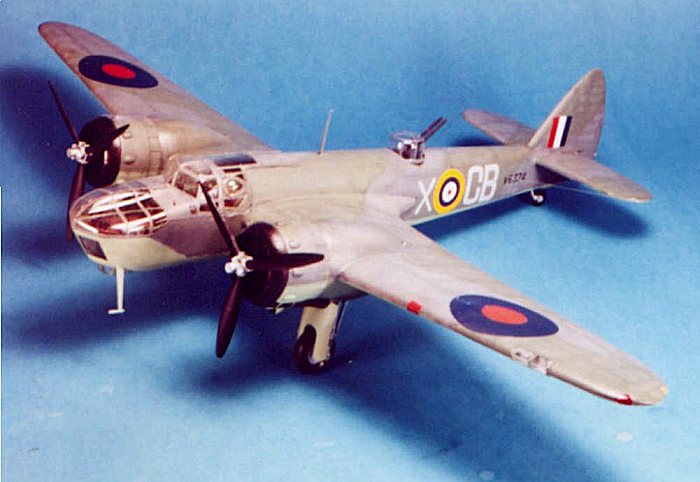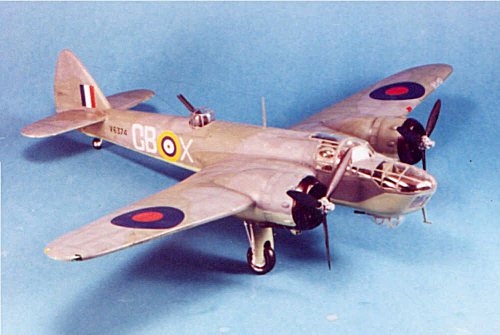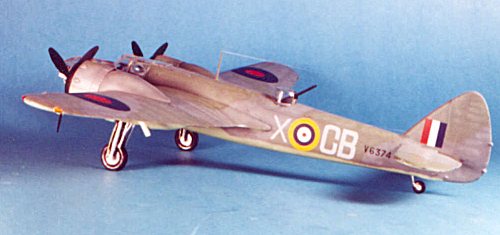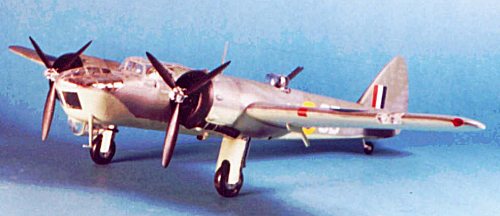
|
KIT: |
Classic Airframes 1/48 Blenheim IV |
|
KIT # |
436 |
|
PRICE: |
$54.95 |
|
DECALS: |
see preview |
|
REVIEW & |
|
|
NOTES: |
Short run multimedia kit |

|
HISTORY |
Following the success of the Blenheim I, Bristol pursued further development of the basic airframe with a design originally called the Bolingbroke, in which the nose of the Blenheim I was extended forward 3 feet. With the windscreen that far from the pilot, visual distortion set in; a more conventional "stepped cockpit, with the glass nose scalloped directly ahead of the pilot to allow good downward visibility during landing was developed. From the rear cockpit bulkhead aft, the airframe was essentially unchanged except for the installation of gas tanks in the outer wings for extended range. The final form was approved in the summer of 1938. Bristol and the other contractors building Blenheims in the "shadow factory" program were directed to change over to what was now called the Blenheim IV in late 1938. By the outbreak of war in September, 1939, 100 Blenheim IVs a month were being delivered to the RAF. Though the airplane was outclassed by its opposition, it would be the primary tactical day bomber of the RAF until replaced by the Mosquito in 1942.
Though the Blenheim had seen combat from the first day of the war, being the first British bomber to raid Germany two hours after the declaration of war on September 3, 1939, the Blenheim did not see widespread combat until the German invasion of France in May, 1940. From then until the fall of 1941, Blenheim crews would almost see too much action. As an example, 82 Squadron made its first attack against the German invasion in Belgium on May 17, 1940, 12 aircraft flying across the Channel to attack a German armored column in Gembloux, Belgium. They missed their rendezvous with the Hurricane squadron detailed to escort them, and pressed on regardless. Just before reaching Gembloux they were intercepted by 15 Bf-109s, which proceeded to shoot down all but one of the Blenheims. Thus began the crucifixion of the Blenheim crews in 2 Group. Basil Embry had lost 7 of 28 attacking the Maastricht bridges four days earlier. Between May 10 and the evacuation of the B.E.F from Dunkirk, the RAF lost 60 Blenheims with their crews to Luftwaffe fighters and deadly light flak no one had expected.
 Through the summer of
1940, the experience of 82 was not untypical of a 2 Group Blenheim squadron,
making daylight attacks in formations of 4-6 aircraft to strike the invasion
ports and the buildup of the German Army in northern France. The squadron
suffered 180 percent casualties by September, going through 3 commanders in one
week alone. Life in a 2 Group Blenheim squadron during the summer of 1940 has
been compared to that of an R.F.C. squadron on the Somme in 1916, with aircrews
being lost on operations before they had completed the process of signing in to
the squadron and being issued their bedding. It was considered by aircrew during
this period that an assignment to 2 Group was effectively a death sentence.
Through the summer of
1940, the experience of 82 was not untypical of a 2 Group Blenheim squadron,
making daylight attacks in formations of 4-6 aircraft to strike the invasion
ports and the buildup of the German Army in northern France. The squadron
suffered 180 percent casualties by September, going through 3 commanders in one
week alone. Life in a 2 Group Blenheim squadron during the summer of 1940 has
been compared to that of an R.F.C. squadron on the Somme in 1916, with aircrews
being lost on operations before they had completed the process of signing in to
the squadron and being issued their bedding. It was considered by aircrew during
this period that an assignment to 2 Group was effectively a death sentence.
The Air Staff was unwilling to admit that the RAF did not have a bomber capable of operating in the European air combat environment in daylight. Packets of Blenheims were shot down like ducks during season by the Luftwaffe. Even worse was the wastage of the pre-war trained aircrews, almost none of whom would survive the war, with the overwhelming majority lost by the end of 1940 to no good purpose. One can compare the high command of the RAF in this period to the incompetence of the British Army High Command on the Western Front during the First World War or those who ordered the charge of the Light Brigade in the Crimean War for wastage of trained men to no account.
On August 13, 1940, 82 Squadron were ordered to attack the German airfield at Aalborg, Denmark. There was no prospect that the attack would meet with success, or that if it did it would have any effect on the air battles over England since the German aircraft using the field were not participating in these operations. Even Sir Charles Portal, Chief of the Air Staff, had told the Air Ministry, "It seems to me the height of folly to throw away the experienced crews on the bombing of aerodromes which, I think you will agree, shows the least result for loss of equipment expended on it." The lead crew included a navigator flying his first mission. His inexperience showed when the formation made landfall on the southern coast of Denmark, rather than the northern tip. As they crossed the shoreline, a Sgt. Pilot who would later be court-martialled for Lacking Moral Fibre aborted the mission. The eleven remaining flew up the length of the country in clear skies at 8,000 feet, with the German defenses thoroughly alerted. As Lord Haw-Haw later reported accurately, five were shot down by fighters and six by flak; 9 aircrew of 33 survived as prisoners.
When the RAF decided to "lean forward into France" in early 1941, a squadron of Blenheims would be escorted by up to eight wings of Spitfires and Hurricanes providing cover in and out for raids against the airfields used by JG26 and JG2. Losses averaged two Blenheims per mission, with Germans like Adolph Galland diving through the escort to blast a Blenheim from the sky as they kept on diving out of range. Between March and June 1941, Galland himself scored 10 Blenheims this way, including two on one day.
 Beginning in the summer
of 1941, 2 Group's Blenheims were detailed to support Coastal Command in Channel
shipping strikes. This usually involved 2-4 Blenheims going up against a convoy
that always included at least one flak ship. A tour of shipping strike
operations during this period lasted two weeks, with the squadron decimated by
losses of 25 to 70 percent in those 14 days. The strikes were ordered by so that
it could be shown that Britain was still an island fortress that could strike at
the enemy.
Beginning in the summer
of 1941, 2 Group's Blenheims were detailed to support Coastal Command in Channel
shipping strikes. This usually involved 2-4 Blenheims going up against a convoy
that always included at least one flak ship. A tour of shipping strike
operations during this period lasted two weeks, with the squadron decimated by
losses of 25 to 70 percent in those 14 days. The strikes were ordered by so that
it could be shown that Britain was still an island fortress that could strike at
the enemy.
Churchill minuted on August 29, 1941: "The loss of seven of seventeen in the daylight attack on merchant shipping and docks at Rotterdam is most severe. Such losses might be accepted in attacking the Scharnhorst, Gneisenau, or Tirpitz, or a southbound Tripoli convoy, because, apart from the damage done, a first class strategic object is served. But they seem disproportionate to an attack on merchant shipping not engaged in vital supply work. While I greatly admire the bravery of the pilots, I do not want them pressed too hard." By that fall, a run of very bad weather and the reassignment of Air Marshal Donald "Butcher" Stevenson as AOC finally saved what was left of the Blenheims of 2 Group.
The Blenheim is immortal in the same way that the horses ridden in the charge of the Light Brigade are immortal. The airplane and its crews were far better than those who ordered them to try and accomplish the impossible.
|
THE KIT |
I will refer you to the preview published here two weeks ago for details of the kit. Suffice it to say here that the Blenheim IV kit is exactly the same as the Blenheim I kit, other than the provision of the longer nose. These two parts are very clear, and result in a very accurate look when the model is completed. Decals include a Blenheim IV of 105 Squadron, 2 Group in the summer of 1941 during the anti-shipping strikes, after camouflage had changed from the day bomber standard of a disruptive pattern of Dark Earth and Dark Green upper surfaces with Sky lower surfaces to the "temperate sea scheme" of a disruptive pattern of Dark Sea Grey and Slate Grey upper surfaces with Sky lower. The alternative is for an all-black Blenheim IVF night fighter of 68 Squadron in the fall of 1940.
|
CONSTRUCTION |
 I will refer you to my
article on building the Blenheim I for details of
construction. The only difference between that kit and this one is that, with
the extended nose, it is essential to glue the interior side panels into the
nose, so that you obtain as strong a bond as possible. For some reason, the
clear plastic used for the nose does not respond well to glues like Tenax or
Ambroid Super Weld. I used cyanoacrylate, and would recommend use of epoxy to
get things strong enough. If you have dipped the clear parts in Future before
doing this, you will avoid fogging. It is essential that parts like the
navigator's table be glued in this way; I attached the table with Ambroid, and
during painting I heard something start rattling inside the cockpit. When I
finished painting and doing decals and removed the tape masks, I discovered to
my horror that the navigator's table had broken loose inside the nose!
Fortunately, I was able to loosen and remove the rear section of canopy glass,
remove the pilot's seat, controls and instrument panel, and fix the table back
in place using techniques learned when putting a ship in a bottle. This was a
long, involved process with no guarantee of success until complete, and I can
assure you the air over the workbench took on a deep purple hue during this.
Like I said: cyanoacrylate or epoxy here.
I will refer you to my
article on building the Blenheim I for details of
construction. The only difference between that kit and this one is that, with
the extended nose, it is essential to glue the interior side panels into the
nose, so that you obtain as strong a bond as possible. For some reason, the
clear plastic used for the nose does not respond well to glues like Tenax or
Ambroid Super Weld. I used cyanoacrylate, and would recommend use of epoxy to
get things strong enough. If you have dipped the clear parts in Future before
doing this, you will avoid fogging. It is essential that parts like the
navigator's table be glued in this way; I attached the table with Ambroid, and
during painting I heard something start rattling inside the cockpit. When I
finished painting and doing decals and removed the tape masks, I discovered to
my horror that the navigator's table had broken loose inside the nose!
Fortunately, I was able to loosen and remove the rear section of canopy glass,
remove the pilot's seat, controls and instrument panel, and fix the table back
in place using techniques learned when putting a ship in a bottle. This was a
long, involved process with no guarantee of success until complete, and I can
assure you the air over the workbench took on a deep purple hue during this.
Like I said: cyanoacrylate or epoxy here.
My one big change to the kit was to open up the windows in the rear section of glass and attach blisters I made by vacuforming an old Monogram Mosquito bomber canopy and cutting off the blisters which were then attached with Krystal Kleer. The early Blenheim IV did not have these, but all those exemplified by the 105 Squadron markings did have them.
|
PAINT & DECALS |
 Painting:
Painting:
I first pre-shaded the model, then painted it freehand (which is how the original would have been repainted from its original camouflage) with Tamiya Dark Sea Grey, Tamiya RLM Gray for the Slate Grey, and Tamiya Sky. Each color was lightened and then re-sprayed to get a fading effect that would have come from the salt spray on these low level missions.
Decals:
I used the kit decals throughout. They are printed by Microscale and go on with no trouble whatsoever under a light coat of Micro-Sol.
|
CONCLUSIONS |
The Blenheim is one of those airplanes that should never have been doing what it became famous for doing. It and its crews became famous for their sacrificial gallantry from England through the Med and North Africa to the Far East during the first three years of the war, during which the Blenheim was all there was. The kit makes up into a good looking model for those willing to put in the effort. I consider it one of the best Classic Airframes has released to date, and well worth the money.
Thanks to Classic Airframes for providing this review kit.
If you would like your product reviewed fairly and quickly by a site that has over 1,300 visits a day, please contact me or see other details in the Note to Contributors.